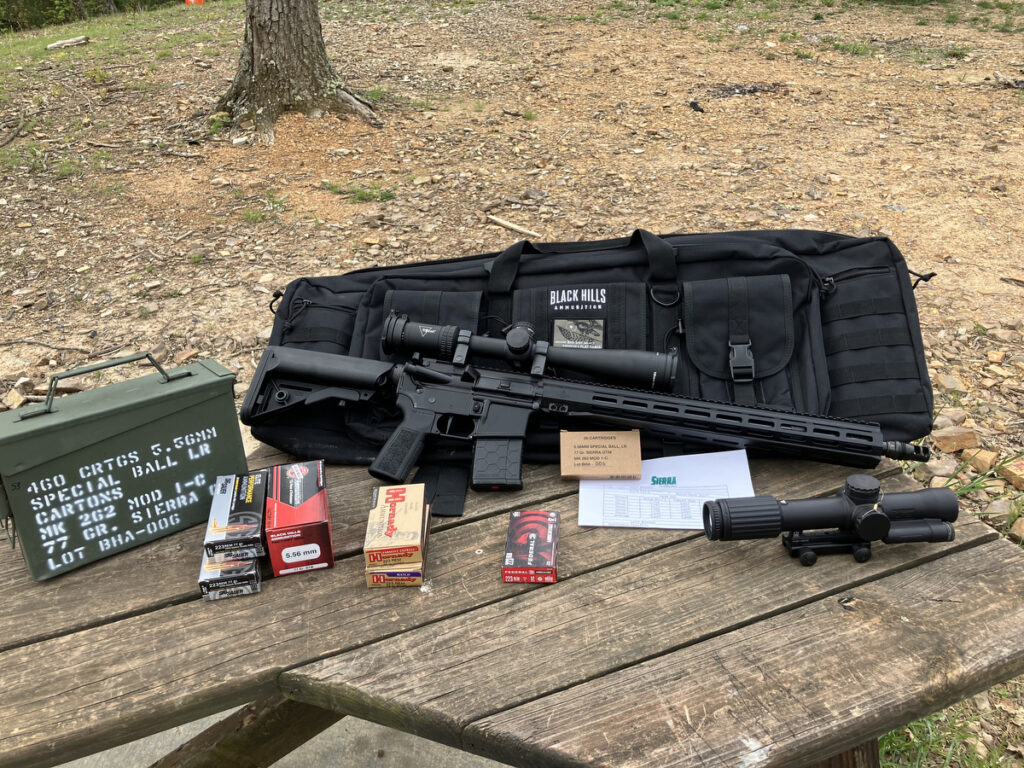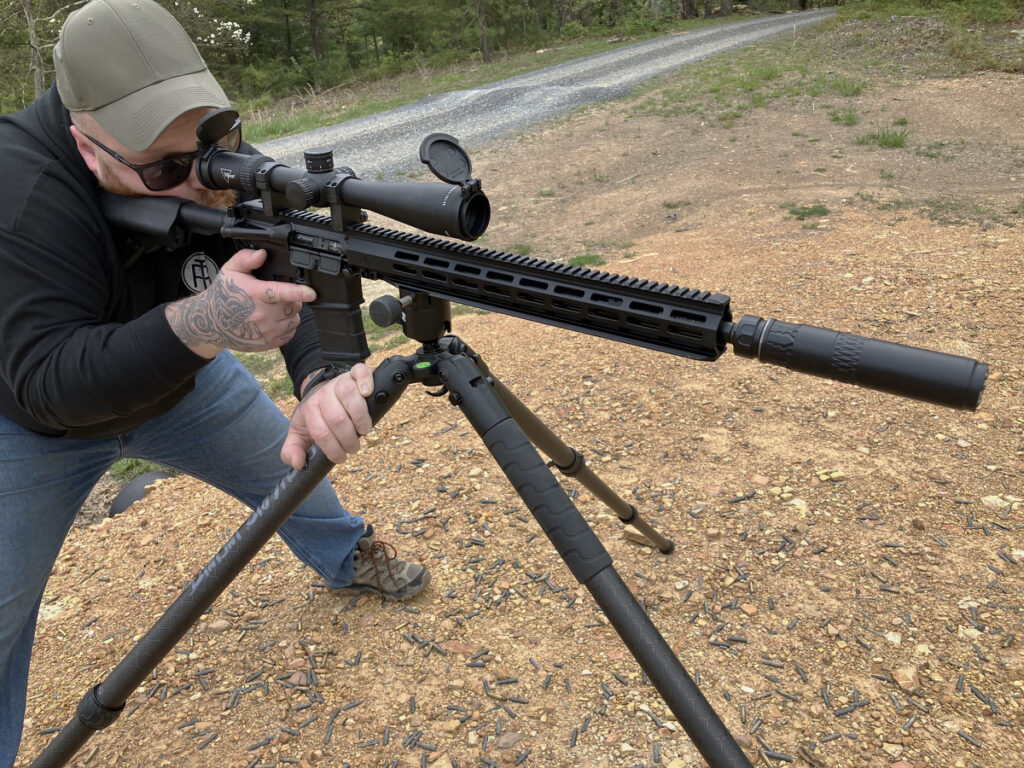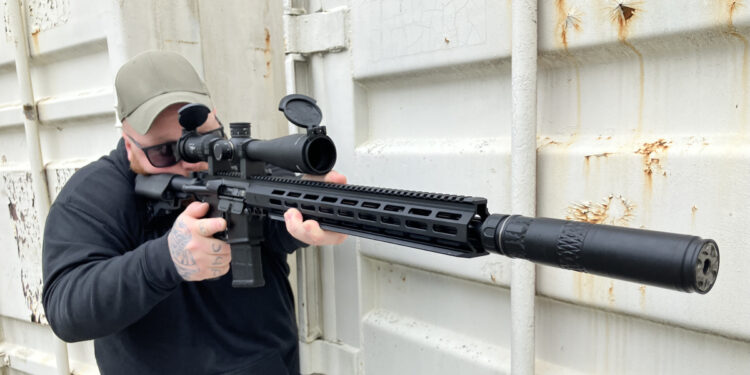Firearms borne from good ideas tend to be versatile, lending themselves to diverse roles, albeit in the duty or civilian arena. Often, multiple manufacturers decide to offer their renditions. Aah…. the joys of capitalism! This is when really you know something works. Let’s get away from this abstract language and provide a specific example. USSOCOM’s SPR (Special Purpose Rifle) 5.56mm AR platform (or the Mk 12, as it’s known in the Navy) is a case in point. A successful military career has led to numerous commercially available examples.
SETTING THE STAGE
The SPR was tentatively explored in the 1990s within certain SOCOM units. What started as a simple upper receiver group upgrade quickly turned into complete rifle program. The SPR originated as a stopgap measure, filling the void between the M4 carbine and the M24 bolt-action sniper rifle roles. The 9/11 attack, resulting in our constant engagement around the world, brought the SPR program quickly to fruition. The SPR became the weapon of choice when dealing with threats at ranges beyond the capability of the M4.

The movie “Lone Survivor”, in which Mark Wahlberg portrays U.S. Navy SEAL Marcus Luttrell, shows the main character using a Mk 12 rifle. The SPR/Mk 12 found favor with SOCOM forces for a multitude of reasons such as its high degree of accuracy, versatility, portability, increased firepower when compared to pure sniper rifles, optics package, suppressor compatibility, more ammunition carried per pound than 7.62 NATO, etc. The Marines eventually started using the SPR, as well, in a DMR role. Examples of military SPR use include by a spotter on a two-man sniper team or as the primary sniping weapon where larger caliber heavy bolt action sniper rifle is not practical, for instance, in a target rich environment where engagement range is between 300-700 yards. Imagine Iraqi urban environments where snipers would hole up in a house, blocks away, to provide cover for clearing troops. The SPR can place rapid precision fire on multiple targets out to 800 yards while still being able to cope with CQB, if required. This firepower capability is grounded in the SPR’s minimal recoil and smooth operation thanks to rifle length gas system coupled with 5.56mm ammunition.
Phased out of production in 2017 by the MK17 (SCAR-H) and MK110A1, the SPR is still used by SOCOM units hoarding the ones left in inventory. Navy SEAL armorers reportedly still produce Mk12s for its teams thanks to their access to discretionary funds. This is a strong supporting statement of the Mk12’s performance.
AMMUNITION SUPPORT
The SPR’s sub-MOA accuracy is an important part of its appeal. This is thanks to the 5.56mm load specifically developed for it by Black Hills Ammunition, the Mk 262 round. Like the SPR rifle, the Black Hills Mk 262 ammunition has been tweaked since its introduction. Updates include a cannelured 77-grain Sierra MatchKing bullet, low flash propellant blend, 5.56mm brass and other un-disclosed proprietary improvements. The Mk 262’s most important characteristic is repeatable accuracy. Black Hills indicates ammunition lot accuracy test consists of 10 groups of 10 shots at 300 yards. No lot ships unless it shoots sub-2-inch groups at 300 yards.

Interestingly, the Mk 262 has unexpected qualities beyond long range accuracy. Mk 262’s terminal performance soon had other SOCOM team members stuffing it into their magazines. Often liberating it from their snipers. How did the 77-grain Sierra MatchKing do this in M4 14.5-inch and Mk18 10.3-inch barrels? The MatchKing’s open tip hollow cavity puts the majority of weight towards the projectile’s rear so that it is more stable in-flight, increasing accuracy. However, when the bullet strikes soft tissue, the heavier base comes around and causes the bullet to tumble. The hollow nose cone breaks off and often the bullet fragments at the cannelure. This happens across a wide range of the velocity spectrum, which is why Mk 262 ammunition proved effective in SBRs in addition to the longer-barreled SPRs.
MODERN RENDITION
As is prone to happen with a rifle requested and proofed by the USSOCOM operators, as word got out about the SPR/Mk 12, civilians wanted it. The SPR was viewed as a multi-purpose weapon. SPR-type ARs can be found overlooking prairie dog towns, predator hunting, as well as in 3-Gun and PRS competitions. Various manufacturers have produced their versions of the SPR. These rifles span the gamut from exact clones to shadowing noteworthy characteristics such as 18-inch match barrel, upgraded trigger, free floated rail, and other accuracy maximizing features.
The SPR that recently caught my eye is the IWI Zion-15 Special Purpose Rifle (SPR). For me the SPR’s most salient features consist of accurate reliable firepower in an easily portable platform. The Zion-15 SPR delivers. The IWI SPR weighs only 7.6 pounds with 18-inch barrel. This is important as an SPR is required to be able to deal with CQB encounters with distances measured in feet while still offering precision fire capability out to 800+ yards.

The IWI SPR is manufactured and assembled at the IWI U.S. facility in Middletown, Pennsylvania. Conversation with IWI U.S. Vice President of Sales and Marketing Jeremy Gresham confirmed certain nuanced attention to detail features in the IWI SPR. For example, IWI makes their own barrels at the Pennsylvania facility with a special 18-inch 5R 1:8-twist, nitride-treated, chrome moly vanadium barrel for the IWI SPR. A collaboration with Timney Triggers finds an IWI-specified two-stage match flat trigger installed in the IWI SPR. The importance of a quality trigger cannot be overemphasized when trying to produce sub-MOA accuracy. A rifle length adjustable gas systems provides the IWI SPR with smooth operation. The adjustable gas block allows for easy adaptation to suppressor use. The IWI website does not mention this important IWI SPR feature. The adjustable gas block was a pleasant surprise when inspecting the rifle upon arrival considering suppressor use is almost standard procedure anymore along with historical precedent of military SPR best practices.

Other thoughtful IWI touches are the built-in full-length ARCA rail on the bottom of the 17-inch MLOK forend. A steel barrel nut is another accuracy enhancing upgrade. A quality barrel nut is a vital component, providing a solid connection and proper alignment between barrel and upper receiver which ultimately contributes to consistent accuracy. B5 Systems adjustable Enhanced SOPMOD buttstock and Type 23 P-Grip finishes off IWI SPR furniture. The B5 pistol grip has a steeper vertical angle than standard pistol grips and an extended tang to improve ergonomics and ensure proper trigger finger index.
SUPPORT COMPONENTS
The versatility of the original SPR platform is indicated by the different optics end users equipped it with, such as 3.5-10x, 2.5-8x, and 3-9x optics. I considered mounting a Trijicon VCOG 1-8x but went with the higher magnification Trijicon Ten Mile 3-18×44. I really wanted to accentuate the precision component of the rifle. I am glad I did once the first range session showed what the IWI SPR could do in the accuracy department. An offset mount featuring a red dot will quell any concerns of the Trijicon Ten Mile 3-18×44, if the IWI SPR is pressed into a close-range affair. The offset optic mount allows a quick rotation of the rifle in the shoulder pocket to access the red dot optic with minimal effort or disturbance of handling.

The SPR was intended to be used primarily suppressed. This was the best way to conceal the origination point of shots taken with it. A lightweight Rugged Suppressors Alaskan360 was an easy choice to mount on the IWI SPR. A Rugged Suppressors 2-port 5.56mm muzzle brake replaced the birdcage flash hider that arrived with the IWI SPR. The Rugged Suppressors brake makes for easy removal and attachment of the Alaskan360 suppressor.

Ammunition tested with the IWI SPR was a combination of Black Hills Ammunition loads—the Mk 262 and civilian version 77-grain OTM, multiple Hornady loads—75-grain BTHP and 55-grain VMAX, SIG Sauer 77-grain OTM and Federal 62-grain FMJ-BT. The IWI SPR rifle kept all loads tested at 1.25-inches or better at 100 yards. Mostly better. The Black Hills loads—Mk 262 and 77grain OTM—SIG Sauer 77-grain and Hornady 75-grain and 55-grain loads produced sub-MOA groups. Some of these groups were in the ½-inch range. Impressive performance. Groups at 200 and 300 yards confirmed 100-yard findings. This is a compliment to IWI SPR’s barrel and trigger, Trijicon optic, and ammunition. At times it felt like the I was letting the IWI SPR down. After firmly establishing what it could do, when a group opens up to an inch or more, you know who the weak link is. The IWI SPR produces accuracy that fully supports the original SPR intended role. Velocity figures ranged from 2700 to 3000 feet per second over a Caldwell chronograph.
FIELD EVALUATION
Real proficiency begins with realistic training scenarios. Range evaluation at Echo Valley Training Center (EVTC) consisted of taking advantage of the recently added 3-gun rifle range with multiple plates set up at four different distances stretching out past 400 yards down a ravine following natural contours. Multiple sizes and shapes of steel plates occupy each station. A Burris Signature HD Spotting Scope 20-60x85mm proved handy for spotting purposes.

The IWI SPR/Trijicon/Rugged Suppressors combo was used in the prone, sitting, kneeling, standing positions, or shooting from a BOG Infinite Deathgrip tripod. The IWI SPR’s ARCA railed forend proved handy for securing into the BOG tripod. The IWI SPR proved to “hang” well from less well supported positions and was very manageable in getting into and out of shooting positions. Another twist is to have a companion pick the target and shooting position for the shooter to engage as quickly as possible.
PERFORMANCE

| Avg. FPS | Avg. 5-Shot Group @100 yd. (in.) | Best 5-Shot Group @100 yd. (in.) | |
| BHA Mk 262 77grain OTM | 2797 | .66 | .562 |
| Hornady 75grain BTHP | 2659 | .75 | .66 |
| Hornady 55grain VMAX | 3086 | .812 | .66 |
| SIG Sauer 77grain OTM | 2672 | .75 | .5 |
Clay pigeons were sniped with regularity at 475 yards from the supported prone position and off the BOG tripod. Felt recoil was minimal (as expected) with a suppressed 5.56mm. With the Rugged Suppressors Alaskan360 attached it was no problem to spot a miss and have another round on the way from the IWI SPR before the spotter could even relay the information.
TWO CENTS
While I appreciated IWI’s choice of a B5 stock and pistol grip, some end users may consider a fixed, precision-oriented buttstock. I will stay with the B5 as I favor the ability to reduce stock length. A gas buster-type charging handle is recommended if firing multiple rounds from one position when suppressed. An extended charging handle is another recommendation, especially with an optic mounted for easier manual operation. Lastly, ambidextrous controls would also have been a nice touch.
IWI indicated that “user subjective” items like charging handle, safety, and muzzle device was left as mil-spec standard so that the end user could build from there. Along these lines I have no issue with bird cage flash hider. With suppressors becoming so popular, its best to allow the end user to choose their muzzle device or just direct thread it onto the barrel. Frankly, IWI’s decisions in this regard make sense when the shockingly low MSRP of $1299 for the IWI SPR is revealed. $1299 for the kind of accuracy exhibited along with an adjustable gas block, ARCA rail forend, and B5 furniture is a great value.

MULTI-PURPOSE
The inherent adaptability of the AR platform is one its greatest attributes. The ability to send bullets downrange accurately, whether for competition, target shooting, military, law enforcement, or personal defense, ensures its place in the rifle marketplace. There is minimal difference between AR labels such as Recon, Recce, SPR, DMR, Mk12, Competition, etc. These ARs are required to be equally at home with close-range hose downs and long-range precision shooting. The IWI SPR rifle is an excellent example of this. The IWI SPR’s handling with superior accuracy is hard to deny. It’s smooth, easy, and accurate. And, best of all, it’s a great value.
SPECIFICATIONS
| Make | IWI US |
| Model | Special Purpose rifle |
| Caliber | 5.56 NATO |
| Weight (empty) | 7.6 lb. |
| Overall Length | 34.75 in. stock extended // 31.5 in. collapsed |
| Barrel | 18 in. 5R rifling 1:8 twist |
| Magazine Capacity | 30-rd (Magpul PMAG incl.) |
| MSRP | $1299 |
| Info | Zion-15 Special Purpose Rifle – 5.56 NATO – IWI US |













